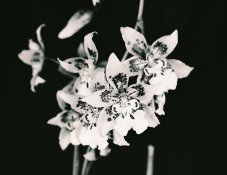My wife raises orchids as her hobby. So it seems that I always have a selection of deep rich colored flowers to photograph. I really want to shot them in B&W but they always seem flat and blah!!!
Here is an example.
Suggestions? Filters?
this was shot with a Nikon F100 and Ilford XP2 Super
********
Yes to other comments about the light being too flat. For myself, I would find the task given you by your bride a tremendous photographic challenge.
The good part, though (at least for me) is that her task does not require use of a stepladder

.
As a former orchid raiser, I can say your need is to show the subtle shadings and different colored striations in the flowers. I would begin my experiments with slightly angled semi-diffuse lighting. I would use a film which has the ability to render subtle detail: the old Adox KB14 comes to mind here. Perhaps EFKE 25 or Ilford Pan F. I would soup the film in Beutler's, or D23 1:3or Rodinal 1:85. I might even try this (in my personal opinion) crapola of stand development for once.
If such approaches did not produce acceptable results, I would then try filtration to lighten the striations.
As I mentioned above, this would be a real challenge for me. Oh, I forgot to mention: certain flowers (I do not know if orchids are one of the type)
reflect light (infrared?) in a part of the spectrum not perceived visually by the human eye, but which can be recorded on film. It is called, iirc, "anomalous reflectance."
And XP2 is certainly not, in my unhumble opinion, a film fit for anything.
This is a job for real film and, perhaps, a larger negative.
Good luck, and keep us posted.












 .
.

